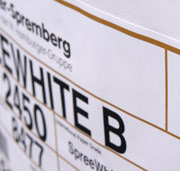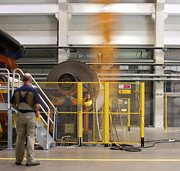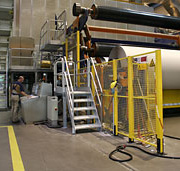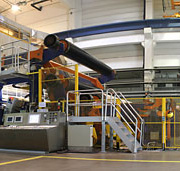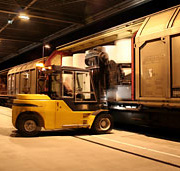A paper factory is basically divided into three plant sections:
- Stock preparation
- Paper machine
- Finishing
Stock preparation
The production process starts with stock preparation. The raw materials delivered in the form of dry bales, waste paper and/or cellulose, are dissolved with a lot of water and freed from impurities. The waste paper comes mainly from households and department stores. The recycling of such waste paper requires a very high cleaning effort: the paper pulp must be fed through a large number of aggregates with perforated and slotted sieves in order to achieve a complete separation of the disturbing impurities.
At the end of stock preparation, additives such as starch, dyes or fillers are added to achieve the required paper properties.
Paper machine
The paper machine takes over the prepared pulp suspension and uses it to produce an endless paper web. Under the term "paper machine" one can imagine a continuous plant more than 100 m long, which is divided into the following three main sections:
- Sieve section
- Press section
- Dryer section
In the first section of the paper machine, the pulp coming from the stock preparation is strongly diluted, so that only about seven grams of fibre and filler are contained in each litre of the fibre/water mixture. This suspension is distributed evenly over the entire working width of a rotating sieve by means of a wide nozzle.
While the water drains off or is sucked off, the fibres deposit on the sieve and form a fibre fleece.
At the end of this so-called sheet formation process, the paper web still contains approx. 80 percent water.
The paper machine in Spremberg has three such sheet forming systems, where the fibre tile is brought together to form a paper web before entering the next process stage. This multilayer structure of the paper web allows high-quality fibre raw materials to be specifically used to produce certain product properties such as whiteness, strength properties, etc.
The paper web is further de-watered through mechanical pressure in the press section. For this purpose, it is guided between rollers by means of felt webs and subjected to a high pressing power. Through the pressing process, a dry content of approx. 52% is achieved and the web strength is increased.
In the subsequent dryer section, the remaining water is evaporated by the supply of heat energy. The paper web is guided slalom-like over steam-heated drying cylinders. A unit for applying starch and glue to the paper surface is installed in the dryer section to selectively control certain strength and printing properties. A smooth surface and an even sheet thickness is ensured by the calender located at the end of the dryer section.
The Spremberg paper machine also includes a coating system. In this process the paper is additionally refined and thus given an even smoother and glossier surface.
After leaving the dryer section within the paper machine, the paper web is subjected to several precise quality controls by means of serious measuring frames. Several parameters such as thickness, colour, basis weight and moisture are measured and their uniform distribution over the entire web width is checked and documented.
At the end of the paper machine, the finished paper web is wound onto steel rolls (reels).
Finishing
Before delivery to the customer, the paper must be cut to the desired length and width. In the winder, the machine rolls are divided into smaller rolls. The finished rolls are then packed to customer specifications and marked with labels.

